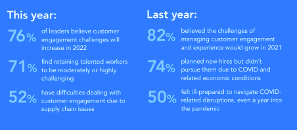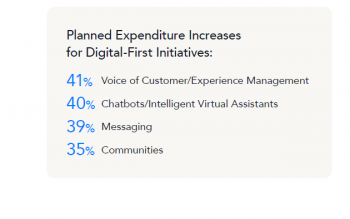Contact centers continue to grapple with delivering exceptional customer experiences in the wake of post-pandemic recovery.
Successfully engaging with customers continues to challenge organizations as they work to recover from the pandemic. In addition to rebuilding their operations and developing a solid workforce, businesses must now adapt to the uncertainty of the global supply chain and staffing shortages in the wake of the Great Resignation.
While brands have gotten over the initial shock, awe, and disruption of COVID, they now are operating with the mantra of “disruption as usual,” needing to respond to the new normal – constant rapidity of change. To gain insights into the key challenges and business priorities, Verint conducted a survey of more than 2,700 global business leaders.
The study pinpoints the latest pressures affecting businesses as they aspire to support new workforce dynamics, ever-expanding customer engagement channels, and exponentially more consumer interactions – all with limited budget and resources. These factors create an Engagement Capacity Gap, which impacts organizations as digital disruption increases.
As organizations move forward in this, the third year of post-COVID operations, three-quarters of companies (76%) expect customer engagement challenges to increase this year.

The Current State of Customer Engagement
Organizations improved the state of customer engagement and experience this past year by implementing and expanding key customer engagement solutions. Tools to support remote working have become integral over the past two years; and, with hybrid working models here to stay, organizations are now working to optimize and fine-tune these solutions for improved quality and performance.
Understanding and acting on consumer behaviors and building enduring customer relationships were the top two challenges noted in last year’s research and remain the top two challenges in the year ahead.
Nearly half of those surveyed (47%) saw obtaining a unified view of customer experience while much of their customer interaction data sits in multiple data silos as a key challenge. Clearly, eliminating these silos to connect customer data, behavior, and results is a work-in-progress to improve the omnichannel customer experience.
Outside factors also are straining the delivery of excellent customer experience. More than half (52%) have customer engagement difficulties stemming from supply chain issues, and an even larger majority (71%) find retaining talented workers to be moderately or highly challenging.
Moreover, challenges continue in developing sustainable work-from-home strategies. Nearly half of respondents (47%) say half or more of their workforce will remain working remotely or in a hybrid manner in the year ahead, but only 62 percent believe they are highly prepared to handle the challenges of distributed workers.
Key Priorities
While growing revenue – the top priority in last year’s study – remains important, acquiring new customers and improving customer experiences top the list of priorities.
Organizations are also placing greater emphasis on quality and performance solutions. This will be a top expenditure as companies invest in new technologies to move beyond traditional approaches. In addition to balancing customer engagement with employee satisfaction, customer acquisition, improving customer experience and employee recruitment and wellness are top priorities.
Last year’s study showed the magnitude of customer behavior shifts. Digital-first engagement, which was a necessity for consumers in the early days of the pandemic, is now becoming the preferential means of communicating with brands.
Correspondingly, budgets for digital-first engagement have risen – a trend that continues in 2022 as companies plan to boost their spending on digital solutions, with 41 percent increasing budgets for voice of the customer and experience management, 40 percent for chatbots and intelligent virtual assistants (IVAs), 39 percent for social messaging for customer service, and 35 percent for communities.

Other key expenditures are focused on agent augmentation and empowering the remote workforce. Moving forward, 35 percent plan to increase their budgets for chatbots and IVAs to help beleaguered agents improve efficiency and decisioning, and 37 percent plan to bolster investments in knowledge management, as “the ability to quickly find information to better serve customers” was noted as a top workforce goal.
Organizations also plan to improve self-service options for consumers to ease the burden on already-overworked employees by leaning into digital channels and automation.
Intelligent automation can help handle the rising number of digital-first interactions and provide a more personalized experience for customers. Simple interactions are handled promptly by self-service solutions, freeing up workers to handle more complex and emotionally charged cases on an individual basis.
Putting Customer and Employee Empathy into Action
Businesses are embracing the means to support kinder, gentler, more human-centric engagement, with technology-infused strategies to safeguard both employee wellness and the delivery of empathic customer engagement.
Key technology initiatives are geared toward improving the human experience. Ninety-one percent have adopted technology and strategies to support greater empathy in their customer engagement efforts for 2022 and 60 percent plan to leverage technology to support improved agent experience and well-being.
To enable exceptional customer interactions at scale requires organizations to strike the right balance between automation and human interaction. Artificial intelligence (AI) continues to drive intelligent engagement: 78 percent say that expanding AI and automation are top priorities, and 84 percent plan to invest in technology to support the right mix of self-service and human-enabled engagement in 2022.
Racing to Resolve the Engagement Capacity Gap
The critical work to close the gap starts with organizations leaning into customer service technology to support digital-first engagement and more empathic connections to level up the customer and employee experience.
In navigating the challenges of the Great Resignation and supply chain disruptions, organizations are struggling with a reduced workforce and limited resources to keep up with evolving and growing consumer demands. As organizations face obstacles with hiring and retaining talented employees, they must provide engaging and meaningful work experiences, the opportunity to succeed in a remote or hybrid environment and the tools to create personalized, productive interactions with customers. Prioritizing investments in customer engagement and experience; choosing automated, scalable solutions; and implementing systems that foster seamless interactions are all ways that organizations can act to close the Engagement Capacity Gap.



